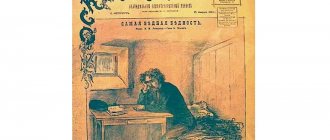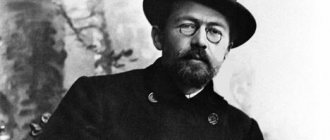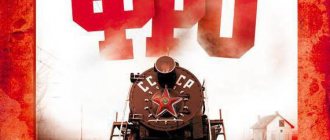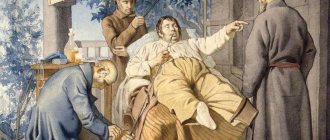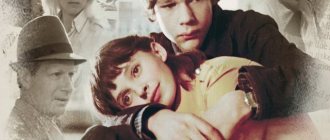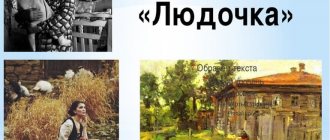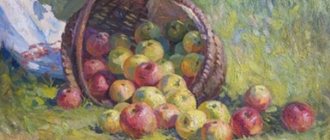Working on a story
Before reading a summary of Chekhov’s “Teacher of Literature,” it is worth getting acquainted with the history of its writing. Work on the work lasted more than one year . The writer, having started the story, then abandoned it for several years and became interested in creating other works.
Only 5 years later Anton Pavlovich returned to his “Literature Teacher”. Soon the work was published. After this, the press began to discuss the style and plot of the story. “The Literature Teacher” has been analyzed by many writers and critics. A. N. Pleshcheev wrote a letter to Chekhov in which he shared his impressions. In his opinion, the story is full of freshness , truth and poetry.
Despite the positive assessments, some literary critics of that time perceived Chekhov's literary creation ambiguously. Many people wondered why it had such an unexpected ending. In their opinion, the reader is completely unclear what will happen to the “new man” next, what his fate will be like after such significant changes in worldview.
Main characters
Before reading the summary of the story “The Literature Teacher,” you should pay attention to its characters. The author introduces the reader to the following characters:
- Sergei Vasilievich Nikitin is a teacher of Russian language and literature at a local school. The key events in the work can be called the teacher’s wedding and the subsequent reassessment of values.
- Maria Shelestova. She is Manya, Manyunya. This is the youngest daughter of a landowner, everyone at home perceives her as small, adores her and pampers her. Masha is fond of horse riding and loves to visit the visiting circus.
- Varvara Shelestova is Manyuni’s older sister, who took on the role of mother. The girl is outwardly attractive, has a lively mind, and received a good education.
- Polyansky. The young man, being a staff captain, attracts Varvara’s attention by visiting the Shelestovs’ house. The girl has hopes of marrying him.
- Shelestov is a local landowner, the father of Masha and Varya, who tenderly cares for his daughters and fulfills all their whims.
The story also mentions Ippolit Ippolitych Ryzhitsky, a teacher of history and geography who lives in the same apartment with Nikitin. Chekhov characterizes him as a boring and boring person who speaks entirely of banalities. During the development of the plot, Ryzhitsky unexpectedly dies, spending the last minutes of his life in delirium.
"Literature teacher"
A teacher of Russian language and literature in a small provincial town, Sergei Vasilyevich Nikitin is in love with the daughter of a local landowner, Masha Shelestova, eighteen years old, whom “the family has not yet gotten used to considering as small” and therefore her names are Manya and Manyusya, and when a circus visited the city, she visited diligently, they began to call her Maria Godefroy. She is a passionate horsewoman, like her father; Often, with her sister and guests (mostly officers from the regiment located in the city), she goes out riding, choosing a special horse for Nikitin, since he is not an important rider. Her sister Varya, twenty-three years old, is much more beautiful than Manyusya. She is smart, educated and, as it were, takes the place of her deceased mother in the house. She calls herself an old maid, which means, the author notes, “she was sure that she would get married.” In the Shelestovs’ house they have their sights set on one of their frequent guests, Staff Captain Polyansky, hoping that he will soon propose to Varya. Varya is an avid debater. Nikitin irritates her the most. She argues with him on every issue and responds to his objections: “That’s old!” or “It’s flat!” This has something in common with her father, who, as usual, scolds everyone behind their backs and repeats: “This is rudeness!”
Nikitin's main torment is his youthful appearance. Nobody believes that he is twenty-six years old; the disciples do not respect him, and he himself does not like them. School is boring. He shares an apartment with a geography and history teacher, Ippolit Ippolitych Ryzhitsky, a most boring man, “with a rude and unintelligent face, like a craftsman, but good-natured.” Ryzhitsky constantly says platitudes: “It’s May now, soon it will be real summer. And summer is not like winter. In winter the stoves need to be heated, but in the summer it’s warm even without stoves...”, etc. During the course of the story, he unexpectedly dies and before his death, in delirium, he repeats: “The Volga flows into the Caspian Sea... Horses eat oats and hay...”
Nikitin, in love with Manya, loves everything in the Shelestov house. He does not notice the vulgarity of their lives. “The only thing he didn’t like was the abundance of dogs and cats and the Egyptian pigeons that moaned sadly in a large cage on the terrace,” however, here too Nikitin assures himself that they moan “because they don’t know how to express their joy otherwise.” As the reader gets to know the hero, he realizes that Nikitin is already infected with provincial laziness. For example, one of the guests finds out that the literature teacher has not read Lessing. He feels awkward and promises himself to read it, but forgets about it. All his thoughts are occupied by Manya. Finally, he declares his love and goes to ask Mani’s hand in marriage from his father. The father is not against it, but “like a man” he advises Nikitin to wait: “It’s only men who get married early, but, as you know, there is rudeness there, but why are you? What kind of pleasure is it to put shackles on yourself at such a young age?
The wedding took place. Her description is in Nikitin’s diary, written in an enthusiastic tone. Everything is fine: a young wife, their inherited house, minor household chores, etc. It would seem that the hero is happy. Life with Manya reminds him of “shepherd idylls.” But one day during Lent, returning home after playing cards, he talks to his wife and finds out that Polyansky has transferred to another city. Manya thinks that he acted “badly” by not making Varya the expected proposal, and these words unpleasantly strike Nikitin. “So,” he asked, restraining himself, “if I went to your house, I certainly had to marry you?” "Certainly. You yourself understand this very well.”
Nikitin feels trapped. He sees that he did not decide his fate, but some dull, extraneous force determined his life. The onset of spring contrastsly emphasizes the feeling of hopelessness that has taken possession of Nikitin. Behind the wall, Varya and Shelestov, who came to visit, are having lunch. Varya complains of a headache, and the old man goes on and on about “how young people today are unreliable and how little gentlemanliness they have.”
“This is rudeness! - he said. “So I’ll tell him straight out: this is rudeness, Dear Sir!”
Nikitin dreams of escaping to Moscow and writes in his diary: “Where am I, my God?! I am surrounded by vulgarity and vulgarity... There is nothing more terrible, more offensive, more depressing than vulgarity. Run away from here, run away today, otherwise I’ll go crazy!”
Brief retelling of the plot
Nikitin had a difficult childhood; he grew up as an insecure person. He is worried about his own youthfulness. It always seems to the young man that his students do not like or respect him, and he himself is not attached to children. Carrying out school activities is accompanied by boredom. Having begun to visit the Shelestovs' house, the provincial teacher falls in love with the youngest daughter of the head of the family, Masha . At that time, the girl was only 18 years old.
Nikitin often accompanies his beloved on horseback rides. Maria even finds him a calm horse that is not capable of throwing its rider. At the same time, the reader watches how Varvara, Maria’s older sister, becomes interested in Staff Captain Polyansky. In her heart, the girl hopes for a quick marriage proposal, but her hopes are not destined to come true.
Soon the wedding of Nikitin and Masha Shelestova takes place, about which the newly-made husband makes an enthusiastic entry in his diary. The newlyweds are happy and full of each other. His wife takes care of Sergei , their life together reminds him of a pastoral. Soon everything subtly changes. The literature teacher begins to feel bored.
One day he returns home in the evening after playing cards, and his wife informs him that Polyansky, on duty, left for another city, which destroyed the hopes of her sister Varya, because there was no proposal. Nikitin seems to have an epiphany. He feels like a pawn in someone else's game. Sergei asks his wife if this means that he, too, had to marry her, since he visited their house. Masha answers in the affirmative, which finally creates some kind of turmoil in Nikitin’s soul.
Events take place in the spring, Sergei’s blues become even more obvious against the backdrop of the awakening of nature and bright spring colors. Nikitin begins to be irritated by everything that happens in life - himself, his wife, her relatives. At the end of the story, the thought of escaping to Moscow begins to dominate in the main character’s head. In his diary, Nikitin writes that sheer vulgarity surrounds him, there is nothing more depressing and offensive than this. The hero notes here that if he cannot change his life, he will simply go crazy.
V. A. Fausek, Chekhov’s acquaintance from Yalta, after reading the story, found it very melancholy and asked the writer to add a few major notes to the text to cheer up the reader. However, Anton Pavlovich ignored the remark made and left the text unchanged. The story was translated into Czech and Hungarian during the writer’s lifetime. Today, a summary of Chekhov’s “Teacher” is popular among schoolchildren, as they study this work in Russian literature classes.
Individual author’s picture of the world in A.P. Chekhov’s story “Literature Teacher”
Bibliographic description:
Korol, L.I. Individual author’s picture of the world in A.P. Chekhov’s story “Literature Teacher” / L.I. Korol, V.N. Nasedkina.
— Text: immediate // Philological sciences in Russia and abroad: materials of the I International. scientific conf. (St. Petersburg, February 2012). - St. Petersburg: Renome, 2012. - pp. 60-63. — URL: https://moluch.ru/conf/phil/archive/26/1841/ (date of access: 09.30.2021). A new approach to the analysis of a literary text allows us to see the conceptual modeling of the author’s picture of the world, as well as to explore the transformation of the content of the dominant individual author’s concepts in the reader’s consciousness. “From the point of view of a literary and artistic work as a form of objectification of the subject of literary and artistic activity and as a subject of critical activity, it is not a literary and artistic work that is infinite in its semantic capacity, but our human ability to introduce more and more new meanings into a literary and artistic work is infinite, our desire to realize our subjectivity is endless” [4, p. 23].
The central category of philological analysis of a literary text remains the image of the author. The image of the author, according to V.V. Vinogradov, is the center of the artistic and speech world, revealing the author’s aesthetic relationship to the content of his own text [1, p.27]. Transformed in the modern scientific paradigm into the individual author’s picture of the world, it, expressing the essence of a work of art, unites its formal and substantive features into an inextricable unity.
The picture of the world of a particular author differs significantly from the objective description of properties, objects, phenomena, from scientific ideas about them, because it is a “subjective image of the objective world.” This is an image of the world, constructed through the prism of the writer’s consciousness and language, the result of his spiritual activity [5, pp. 42-43]. The author determines the concept, the structure of the narrative, the system of images, style, manner of speech, symbolism, etc. Thus, giving preference to one or another fragment of reality, offering his own assessment, describing all this with specially selected words, the author introduces the reader into his creative workshop, inviting him to “co-creation of those who understand” (M. Bakhtin). A literary text, with all its diversity and multidimensionality, has an objective artistic and semantic center, to which the author directs the reader’s attention in all ways available to him, through the work itself, and through its entire multi-level structure. From these positions, we will attempt to analyze the individual author’s vision of the world proposed by A.P. Chekhov in the story “The Literature Teacher.”
It is known that in his early stories A. Chekhov reflected on different types of “false ideas,” which were stereotypical life models of behavior, standards by which a person’s entire life is built. The story “The Literature Teacher” also appears in this series. The destruction of stereotypes begins with the title: words placed in a strong position orient the reader to the perception of information about people of a certain type of occupation, about teachers, moreover, about literature teachers. However, the story - in this regard - disappoints the readers' expectations. Unless the main question remains: if educated people, called to lead others, do not themselves understand what they want, what kind of future is in store for Russia? In addition, some types of teachers are represented here, but none of them, including the main character, can serve as role models.
The first part of the story corresponds to the initial stage of the protagonist’s love: courtship and explanation; the second part presents the family life of a young couple. Everything is as it happens in life, everything is according to a given scenario. However, here too the author makes the reader think: is life really good according to the standard? Teacher Nikitin, having everything necessary for a prosperous life in accordance with generally accepted opinion, writes in his diary: “Where am I, my God?! I am surrounded by vulgarity and vulgarity. Boring, insignificant people, pots of sour cream, jugs of milk, cockroaches, stupid women... There is nothing more terrible, more offensive, more depressing than vulgarity. Run away from here, run away today, otherwise I’ll go crazy!” [cit. from: 7].
One of the creative features of A. Chekhov is considered to be the lack of answer to questions: most often he does not answer, but only poses questions. Nevertheless, the author's position is present in the text of the work of art. For example, the doom of teacher Nikitin’s first love can be seen in a number of details. From the very beginning of the story, the author sets the motive for the unreality of what is happening, a game, a buffoonery. This can be seen in a certain sequence of “excellent and expensive” horses leaving the stable, in addressing his daughter with the nickname “Marie Godefroy”, in the circus exclamation: “Ooplya!”, in moving in a circle (city garden, country garden, Shelestov farm and back) “a long beautiful cavalcade”, in the greater role of animals in what was happening: “And whether it was because her Giant was in great friendship with Count Nulin, or it happened by chance, she, like yesterday and the day before, rode all the time next to Nikitin,” in the author's assessment, reminiscent of the truth, love is blind
: “And he looked at her small slender
body
, sitting on a white proud animal, at her thin profile, at the top hat
that did not suit her at all and made her look older
than she was, he looked with joy, with tenderness, with delight, I listened to her, understood little and thought: “I give myself my word of honor, I swear to God that I will not be shy and will explain myself to her today...” (our italics - L.K., V.N.)
The romantic mood that gripped the young people during the walk is conveyed by the author with the help of traditional landscape sketches: “It was seven o’clock in the evening - the time when white acacia and lilac smell so strongly that it seems that the air and the trees themselves are freezing from their smell. Music was already playing in the city garden. <…>And how warm it is, how soft-looking the clouds are scattered in disorder across the sky, how meek and cozy the shadows of poplars and acacias are - shadows that stretch across the entire wide street and cover the other side of the house right up to the balconies and second floors ! However, the author’s voice seems to remind us of reality: “Wherever you look, everywhere is green, only here and there they turn black
there are melon trees and far to the left in
the cemetery
there is a white stripe
of blossoming
apple trees.
We drove past the slaughterhouses,
then, past
a brewery
, we overtook a crowd
of soldier
-musicians hurrying to a country garden”;
“... all the crow’s nests were visible, looking like big hats.”
Later, these details will emerge in Nikitin’s dream: “ On the porch of the brewery
, the same one we passed by today, Manyusya was sitting and saying something.
Then she took Nikitin by the arm and went with him to the country garden. Then he saw oak trees and crow’s nests that looked like hats.”
In the second part of the story, the motif of the nest arises again: “He continually watched how his reasonable and positive Manya
was making a nest
, and he himself, too, wanting to show that he was not superfluous in the house, did something
useless
, for example, he rolled out a charabanc from the barn and looked at it from all sides.” Thus, the connection of paragraphs forms a single dynamic structure; the multidimensionality of the author’s picture of the world is revealed both when studying the linear development of the text, and when studying distant comparisons of various elements.
A. Chekhov uses symbols familiar to literature. The story contains images such as garden, rain, crescent moon, morning, spring, flowers. These symbols enliven the narrative and supplement it with mental information. One of the cross-cutting images of A. Chekhov’s work is rain - a symbol of the hopelessness of everyday life, the impossibility of true happiness. The rain comes just at the moment when the literature teacher Nikitin begins to realize the illusory nature of the happiness he has received: “One day during Great Lent, at midnight, he was returning home from a club where he was playing cards. It was raining, it was dark and dirty"
.
The image of a garden is also constantly present in A. Chekhov’s stories. This is a symbol of goodness, beauty, humanity, meaningfulness of existence, love. The garden is full of the music of happiness, it is a haven for lovers, where even tulips and irises ask “to be declared in love.” The sudden insight of the literature teacher, who has experienced the intoxication of the illusion of happiness, is illuminated by the bright March sun and sounded by the noise of starlings in the garden, which leaves hope for Nikitin’s escape from vulgarity.
The instability and instability of the love situation that the author describes and the consequences of which he knows is also emphasized by the presence of contrasts and contradictions in its description. This is manifested in the use of far from romantic details when describing heroes experiencing sublime feelings (to those already mentioned, one can also add the description of the beloved as “a passionate horsewoman, like her father”); constant mention of animals (horses, dogs, as well as Egyptian pigeons), even a letter to his beloved Nikitin was going to begin with the address “my dear rat.” At the end of the story, the author will call everything in his own words: “He guessed that the illusion
has dried up and a new,
nervous, conscious life
, which is not in harmony with peace and personal happiness
.
The association with Pushkin’s line “There is no happiness in the world, but there is peace and will” also strengthens a number of contradictions: the hero himself deprived himself of his will, lost peace and did not acquire personal happiness.
After all, Father Manyusi warned him: “I am very grateful to you for the honor that you show me and my daughter , but
let me talk to you in a friendly way.
I will speak to you not as a father, but as a gentleman to a gentleman. Tell me, please, why do you want to get married so early? It’s only men who get married early, but
there is known rudeness there, but why are you? What kind of pleasure is it to put shackles on yourself at such a young age?
The story seems to compare the fates of two sisters: the groom came to the younger one and then proposed to her, that is, everything was as it should be; Staff Captain Polyansky visited the eldest, but did not make an offer. Manyusya’s father was not satisfied with this option either: “This is rudeness! - he said. “So I’ll tell him straight out: this is rudeness, dear sir!”
The very description of the elder sister is also based on comparison: “She was already 23 years old, she was pretty, more beautiful than Manyusya, was considered the smartest and most educated in the house and behaved respectably, strictly, as befitted the eldest daughter, who took the place of the deceased in the house.” mother. <…> She called herself an old maid, which means she was sure that she would get married. She always turned every conversation, even about the weather, into an argument. She had some kind of passion - to take everyone at their word, to expose them to contradictions,
find fault with the phrase.
You start talking to her about something, and
she is already looking intently into your face and suddenly interrupts: “Excuse me, excuse me, Petrov, the day before yesterday you said the exact
opposite
!”
The content in a literary text is closely related to the formal, therefore the author uses a large number of syntactic constructions with an adversarial nature of the relationship. These are mainly sentences with the conjunctions BUT, A, with the particle ZHE as an adversative conjunction (according to M. Bakhtin, this is a statement “with a slight subjective shadow”), and the density of use increases towards the last page, where such constructions occur in different versions 7 times : “And in fact, in the morning he was already laughing at his nervousness and calling himself a woman ,
but
it was already clear to him that peace was lost, probably forever, and that happiness was no longer possible for him in a two-story unplastered house” (with the union BUT - 5 constructions), “...he
,
Nikitin, like a Czech, knows how to hide his stupidity and cleverly deceives everyone, pretending
that
, thank God, everything is going well for him,” “In the next room they drank coffee and talked about headquarters Captain Polyansky,
but
he tried not to listen and wrote in his diary...”
The reader discovers the presence of the author in improperly direct speech. Non-authorial narration shakes the boundary between the narrator and the character, which contributes to the creation of narrative polyphony, manifested in the internal dialogization of the narrative, when “the dialogue goes into the molecular and, finally, into the intra-atomic depths” [6, p. 124].
Non-author’s narration, like any other artistic technique, contributes to the comprehension of the author’s intention, the author’s strategy, and as a result, the meaning of the literary text as a whole. So, unexpectedly, a separately placed quoted phrase bursts into Nikitin’s memories and his thoughts about the upcoming explanation: “Boring, boring, boring!”
. Who's bored? Why boring? Before the upcoming declaration of love? Once again the author intervened in the usual course of events and asked the reader a question.
One of the characteristic features of A. Chekhov’s individual style is the use of allusions and reminiscences as an artistic device. Allusions are one of the ways of implicitly expressing meaning that refers to certain background knowledge of the reader. For example, the family called Manyusya Maria Godefroy, which testified to her passion for the circus and horses (Maria Godefroy is a real person. A. A. Suvorin wrote to Chekhov on September 6, 1888 from Feodosia: “The circus prima donna Maria Godefroy is a thick brunette, quite beautiful - The rider is really beautiful and rides dashingly..."). Reminiscence allows you to reproduce features that evoke memories of other works. Reminiscence is designed for the memory and associative perception of the reader. For example, Varya’s indignation at Nikitin’s remark: “Oh, no wonder, no wonder she’s with the hussar!” - during a game confession it becomes clear if we recall M. Lermontov’s epigram, widespread at that time: “It’s not for nothing, it’s not for nothing // With a retired hussar.” (The work of M. Yu. Lermontov, who wrote about the “coolness” of the soul of modern man, had a profound impact on A. Chekhov).
One of the techniques for depicting the individual author’s picture of the world can be called giving a fragment of text a philosophical and ironic meaning, which arises as a result of inconsistency, correlation of the exorbitantly large, significant with the small, insignificant: “In October, the gymnasium suffered a heavy loss: Ippolit Ippolitich fell ill with erysipelas and died . The last two days before his death he was unconscious and delirious, but even in his delirium he said only what everyone knows: “The Volga flows into the Caspian Sea... Horses eat oats and hay...”.
Using a somewhat paradoxical proposition, the author provokes the reader to search for an answer that will allow him to correctly characterize the hero: “Nikitin felt an unpleasant aftertaste in his soul and could not understand why it was: was it because he lost twelve rubles at the club, or because that one of the partners, when they were paying, said that Nikitin doesn’t have a lot of money, obviously hinting at a dowry?”
One cannot ignore the word “for some reason,” typical of A. Chekhov. Numerous reservations of the narrator, who turns from an all-knowing, all-knowing person into an equal to the reader, turn out to be very important. Emphasizing ignorance of the reason using the word “for some reason,” the author encourages the search for a solution, which may be hidden in the text of the story, or perhaps in the reader’s life experience.
The subject of creative research for A. Chekhov is the complex and contradictory inner world of man, the world of the human soul. In short stories, the writer reproduces the stories of different people, changes in their life positions, foundations. Using specific examples, he poses problems of great universal significance, asks questions and forces the reader to think about the answers.
Modern foreign literary scholars have repeatedly pointed out in their works the commonality of A.P.’s creative method. Chekhov and James Joyce. In the works of both writers, external fablelessness hides intense internal action. The transfer of action to the internal sphere leads to the fact that “a shift in consciousness, a spiritual revolution constitute the main essence and leading compositional moment of Chekhov’s works” [2, p.83].
In the works of D. Joyce, the concept of epiphany (illumination) developed by him acquires great importance. Epiphany-illumination becomes a kind of moment of catharsis in each story, and the plot denouement in this case is unnecessary. A “shift in the consciousness” of the hero as a result of insight does not always occur, and the insight itself is not available to every character, but is given to the reader. The moment of insight does not come as a result of the hero’s spiritual work, but “in the collision of internal and external, due to their tragic incompatibility” [3, p. 17].
So, in the individual author’s picture of the world of A.P. Chekhov, presented in the story “Literature Teacher”, the following are reflected:
- artistic design;
- a system (namely a system, not a random set) of artistic images, compared with each other or opposed to each other;
- dialogue of paragraphs (both nearby and distantly located);
- improperly direct speech;
- sentence construction (presence of adversative conjunctions BUT, A, ZHE);
- Chekhov's “for some reason”;
- the collision of mental background knowledge with an artistic task;
- allusions and reminiscences.
Literature:
- Vinogradov V.V. On the theory of artistic speech. – M.: Nauka, 1971. – 413 p.
- Gerson Z.I. Composition and style of narrative works by A.P. Chekhov // Creativity of A.P. Chekhov. M.: Uchpedgiz, 1956. – 384 p.
- Gildina A.M. Short stories by J. Joyce: context, text, intertextuality: author's abstract. dis. Ph.D. Philol. Sci. Chelyabinsk, 2003. 21 p.
- Karpov I. N. Prose of Ivan Bunin. – M.: Flinta: Nauka, 1999. – 336 p.
- Maslova V.A. Poet and culture: the concept sphere of Marina Tsvetaeva. – M.: Flinta: Science. 2004. 256 p.
- Popova E. A. Egocentric elements of language in non-author’s own narration // Anthropocentrism of the modern linguistic situation. – Lipetsk: Leningrad State Pedagogical University, 2002. – 214 p.
- Chekhov A.P. Complete collection of works and letters in 30 volumes. Essays. In 18 volumes. Volume 8. M., “Science”, 1986).
Key terms
(automatically generated)
: Chekhov, literature teacher, author, literary text, individual author's picture of the world, literary work, story, reader, main character, country garden.
